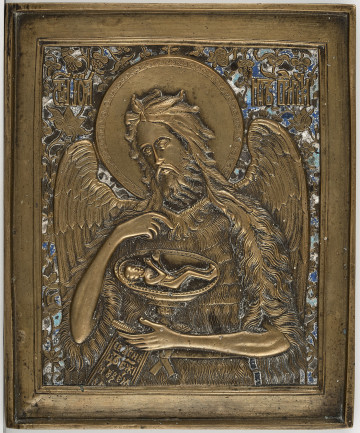
St. John the Baptist
20th century
Castle Museum in Łańcut
Part of the collection: Icons
Multi-panel icon with the principal depiction of the Resurrection and the Harrowing of Hell is a calendar icon, showing the most important feasts of the liturgical year in Eastern Christianity. Calendar icons, known as 'menologions', appeared in Byzantium; since the 16th c., they became popular in the lands of former Rus, see S.12766MŁ, S.12948MŁ, S.12949MŁ. The depictions illustrating individual feasts in calendar icons are read just like written text - in horizontal rows, from left to right and from top to bottom. On the annual calendar icon, feasts are depicted in accordance with the chronology of the events in the New Testament. The series opens with the fixed feast of the Nativity of Mary, celebrated on the 21st of September (September 8 in the Julian calendar), which opens the liturgical year in Eastern Christianity. The subsequent celebrated events from the New Testament are (Julian calendar dates in parentheses): Entry of the Theotokos into the Temple - celebrated on December 4 (November 24); Annunciation of the Mother of God - celebrated on April 7 (March 25); Nativity of Jesus - celebrated on January 7 (December 25); Presentation of the Lord at the Temple - celebrated as 'Srietienije' on February 15 (2); Theophany of the Lord or the Baptism of Christ - celebrated on January 19 (6); Transfiguration of the Lord - celebrated on August 19 (6); Entry of Christ into Jerusalem, customarily Palm Sunday - on the last Sunday before the Resurrection Sunday; Ascension of Christ - celebrated on the fortieth day after the Resurrection; Pentecost or the Descent of the Holy Spirit upon the Apostles - celebrated on the fiftieth day after the Resurrection; Dormition of the Theotokos - celebrated on August 28 (15); Exaltation of the Cross - celebrated on September 27 (14). The most important feast, the Resurrection of Christ, depicted centrally, is described under S.12948MŁ. Teresa Bagińska-Żurawska https://orcid.org/0000-0002-9243-3967
Dimensions
height: 54 cm, width: 44.5 cm
Object type
Icons
Technique
gilding, tempera
Material
gold, tempera, wood
Origin / acquisition method
decyzja administracyjna
Creation time / dating
Creation / finding place
Owner
Castle Museum in Łańcut
Identification number
Location / status

20th century
Castle Museum in Łańcut

19th (?) century
Castle Museum in Łańcut

1800 — 1850
Castle Museum in Łańcut
DISCOVER this TOPIC
Castle Museum in Łańcut
DISCOVER this PATH
Educational path